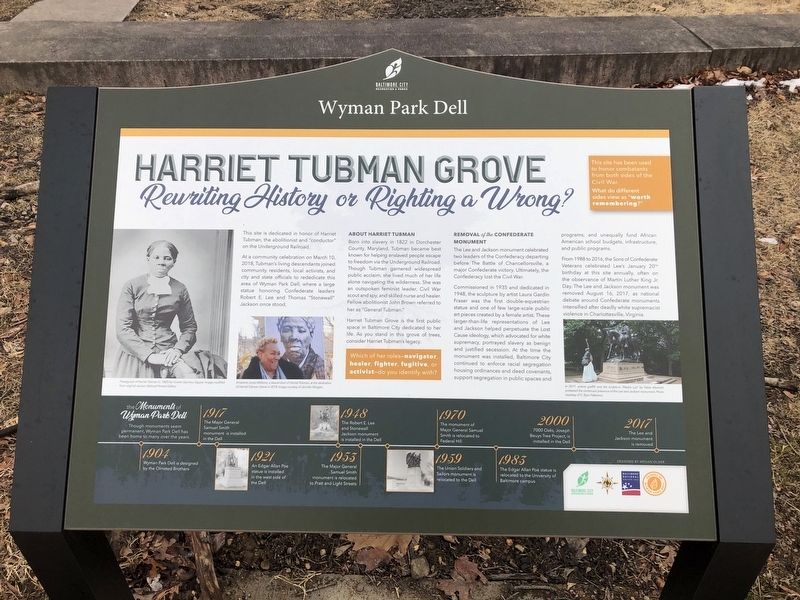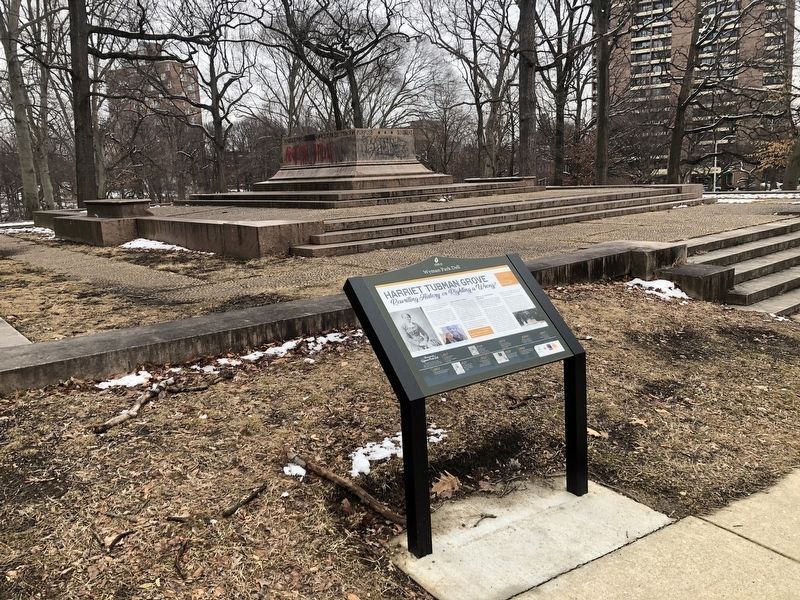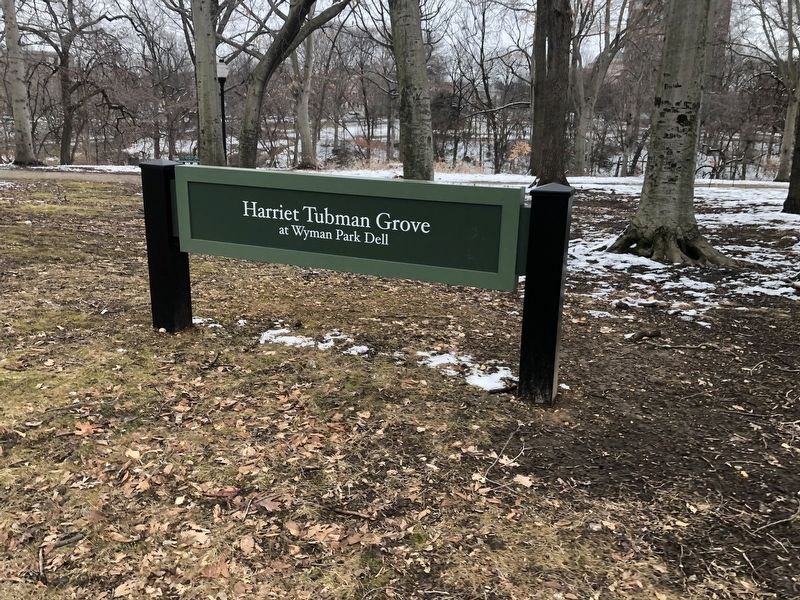Johns Hopkins Homewood in Baltimore, Maryland — The American Northeast (Mid-Atlantic)
Harriet Tubman Grove
Rewriting History or Righting a Wrong?
— Wyman Park Dell —
This site has been used to honor combatants from both sides of the Civil War.
What do different sides view as "worth remembering?"
This site is dedicated in honor of Harriet Tubman, the abolitionist and "conductor" on the Underground Railroad.
At a community celebration on March 10, 2018, Tubman's living descendants joined community residents, local activists, and city and state officials to rededicate this area of Wyman Park Dell, where a large statue honoring Confederate leaders Robert E. Lee and Thomas "Stonewall" Jackson once stood.
About Harriet Tubman
Born into slavery in 1822 in Dorchester County, Maryland, Tubman became best known for helping enslaved people escape to freedom via the Underground Railroad. Though Tubman garnered widespread public acclaim, she lived much of her life alone navigating the wilderness. She was an outspoken feminist leader, Civil War scout and spy, and skilled nurse and healer. Fellow abolitionist John Brown referred to her as "General Tubman."
Harriet Tubman Grove is the first public space in Baltimore City dedicated to her life. As you stand in this grove of trees, consider Harriet Tubman's legacy.
Which of her roles—navigator, healer, fighter, fugitive, or activist—do you identify with?
Removal of the Confederate Monument
The Lee and Jackson monument celebrated two leaders of the Confederacy departing before The Battle of Chancellorsville, a major Confederate victory. Ultimately, the Confederacy lost the Civil War.
Commissioned in 1935 and dedicated in 1948, the sculpture by artist Laura Gardin Fraser was the first double-equestrian statue and one of the few large-scale public art pieces created by a female artist. These larger-than-life representations of Lee and Jackson helped perpetuate the Lost Cause ideology, which advocated for white supremacy, portrayed slavery as benign and justified secession. At the time the monument was installed, Baltimore City continued to enforce racial segregation housing ordinances and deed covenants, support segregation in public spaces, and unequally fund African American school budgets, infrastructure, and public programs.
From 1988 to 2016, the Sons of Confederate Veterans celebrated Lee's January 20TH birthday at this site annually, often on the observance of Martin Luther King Jr. Day. The Lee and Jackson monument was removed August 16, 2017, as national debate around Confederate monuments intensified after deadly white supremacist violence in Charlottesville, Virginia.
The Monuments of Wyman Park Dell
Though
1904: Wyman Park Dell is designed by the Olmsted Brothers
1917: The Major General Samuel Smith monument is installed in the Dell
1921: An Edgar Allen Poe statue is installed in the west side of the Dell
1948: The Robert E. Lee and Stonewall Jackson monument is installed in the Dell
1953: The Major General Samuel Smith monument is relocated to Pratt and Light Streets
1959: The Union Soldiers and Sailors monument is relocated to the Dell
1970: The monument of Major General Samuel Smith is relocated to Federal Hill
1983: The Edgar Allen Poe statue is relocated to the University of Baltimore campus
2000: 7000 Oaks, Joseph Beuys Tree Project, is installed in the Dell
2017: The Lee and Jackson monument is removed
Erected by Baltimore City Recreation & Parks.
Topics. This historical marker is listed in these topic lists: Abolition & Underground RR • African Americans • War, US Civil • Women. A significant historical date for this entry is January 20, 2018.
Location. 39° 19.461′ N, 76° 37.202′ W. Marker is in Baltimore, Maryland. It is in Johns Hopkins Homewood.
Other nearby markers. At least 8 other markers are within walking distance of this marker. Joseph Beuys Tree Partnership (within shouting distance of this marker); Wyman Park Dell (within shouting distance of this marker); Spring House or Dairy - c. 1812 (about 300 feet away, measured in a direct line); Lion (about 300 feet away); Chapin A. Harris (about 400 feet away); a different marker also named Wyman Park Dell (about 600 feet away); Union Soldiers and Sailors Monument (about 600 feet away); Decker Quadrangle (approx. 0.2 miles away). Touch for a list and map of all markers in Baltimore.
Credits. This page was last revised on August 24, 2023. It was originally submitted on February 15, 2021, by Devry Becker Jones of Washington, District of Columbia. This page has been viewed 797 times since then and 115 times this year. Photos: 1, 2, 3. submitted on February 15, 2021, by Devry Becker Jones of Washington, District of Columbia.


